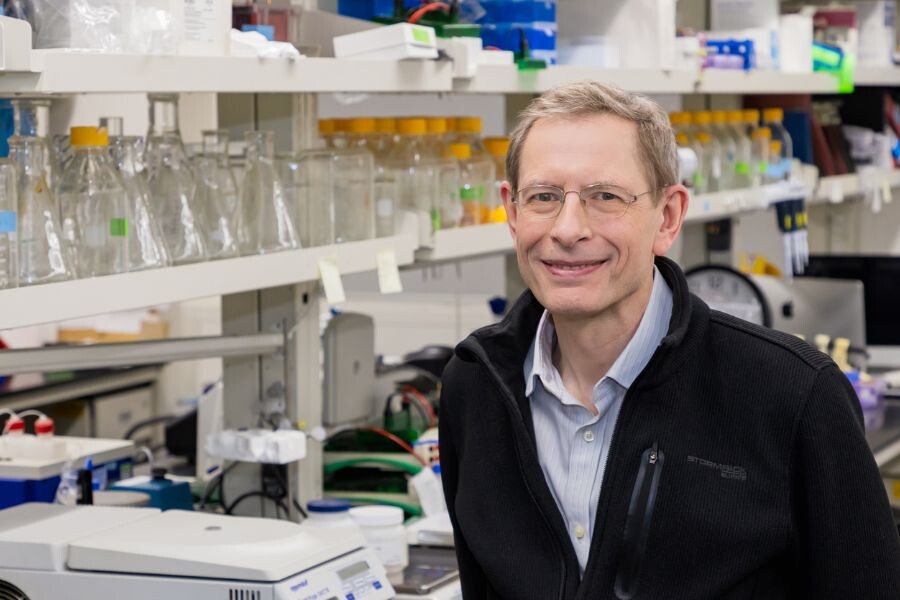
Dr. Myron Cybulsky, Professor and Research Co-Vice Chair in the Department of Laboratory Medicine and Pathobiology in the Temerty Faculty of Medicine, has recently had his Tier One Canada Research Chair renewed. This, he hopes, will allow him and his team to change the way we think about inflammation and atherosclerosis.
Atherosclerosis is a chronic inflammatory disease leading to plaque build-up in arteries. It is the main underlying cause of cardiovascular disease, the top cause of death in the world. The mechanisms of this disease is something Cybulsky has been investigating since he was in medical school, and further developed as a postdoctoral researcher in Harvard before starting his own research lab.
As a Cardiovascular Pathologist at University Health Network (UHN), he knows only too well the damage atherosclerosis can do, as he experiences it in his clinical work doing autopsies related to cardiovascular incidents and assessing transplant biopsies for acute cellular rejection in heart transplants. His research lab, however, looks at the discovery of the mechanisms that can instigate this disease, rather than the poor outcomes patients experience later in life.
This disease is associated with plaque build-up – something that happens gradually over time, often decades. In the later stages of the disease, the plaque can become unstable and its disruption can cause a blood clot leading to a heart attack, when a coronary artery is blocked, or a stroke when it affects blood flow to the brain.
Scientific research has shown that macrophages (a type of white blood cell that ingests and kills microorganisms, removes dead cells, and stimulates the action of other immune system cells) can accumulate lipid, forming foam cells – a hallmark of atherosclerotic plaque. In atherosclerosis, inflammation in the artery triggers monocytes, which are a type of white blood cell made in the bone marrow, to be recruited from the blood into the inner artery wall where they become macrophages. The Cybulsky Lab is investigating why this process begins.
“If we stop monocytes from entering the atherosclerotic plaque, that will stop atherosclerosis - it's a chronic inflammatory disease,” he explains. “The plaque starts out as a macrophage-rich lesion. Over time other cells are recruited into the plaque, such as smooth muscle cells from the artery wall, and high lipid content and macrophage death makes the plaques unstable. But the driver of all of this is still inflammation, even in unstable plaques”.
The thought in the field is that the uptake of lipid by the macrophages was the fuel driving the inflammation in atherosclerotic lesions. However, several recent studies have suggested this may not be the case. For example, when macrophages were isolated from atherosclerotic plaques, inflammatory signatures were not found in lipid-rich foamy macrophages.
The Cybulsky Lab has been studying the mechanism of how lipid accumulation in macrophages actually inhibits pro-inflammatory signaling, in terms of both immunometabolism and epigenetics. “There are important metabolic differences in how macrophages with accumulated lipid respond to stimuli that provoke an inflammatory response. We now have a better understanding of the mechanisms and have recently submitted this for publication.”
Using single cell transcriptomics, the Cybulsky Lab can simultaneously examine the RNA expression of hundreds of genes in individual cells of a given population. This technique has given them insights into which cells in the atherosclerotic plaque may actually drive inflammation.
“Other people in the field have been isolating cells from the entire aorta after digesting it, and then looking at the biology of cells in the atherosclerotic plaque that constitutes only a small fraction of the cells of the entire aorta. We’re doing things differently; we have used a micro- dissection technique where we only isolate cells from the inner surface of the aorta where the atherosclerotic lesions are located. We’ve completed transcriptomics on cells from early atherosclerotic lesions in mice and now understand that it is not the lipid-rich macrophages, but the newly recruited monocytes that express inflammatory genes and thus provide the signals that drive inflammation in atherosclerosis”, he explains.
First awarded the Canadian Research Chair in 2015 which funded this exploration, the renewal allows the work to be completed as it funds Cybulsky for another seven years.
“The CRC and a Foundation grant from the Canadian Institutes of Health Research (CIHR) have allowed us to invest into emerging techniques such as single cell transcriptomics and importantly the CRC protects time that I can devote to research as a hospital-based clinician. It means we can bring this research to publication and move onto discovering new things!”